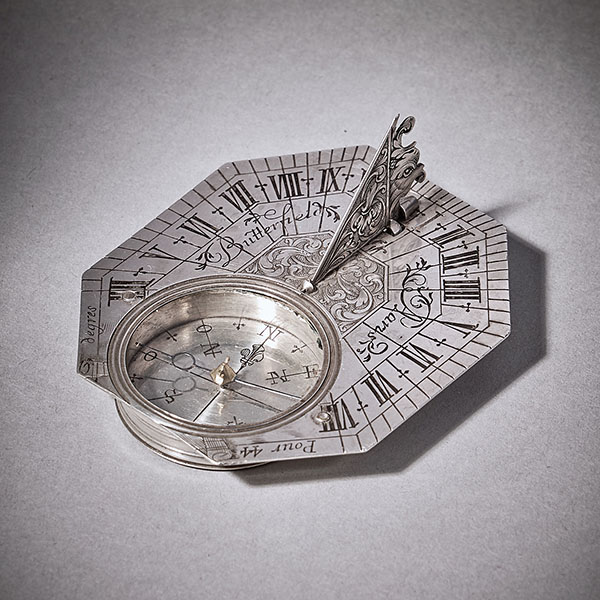An Extremely Rare Geometric George II Parquetry Cocuswood Tea Caddy, Circa 1730
Sold
Follow Us
An Extremely Rare Geometric George II Parquetry Cocuswood Tea Caddy, Circa 1730
Adorned with a white metal handle the cross banded, moulded and ebony inlaid top sits over a similar cross-grain inlaid frieze, entirely veneered in small sections of choice cuts of cocuswood incorporating sapwood to each face.
Raised on the original cross-grain moulded base and four bracket feet.
The interior is later lined in a burgundy velvet.
The stop hinges and lock appear to be original.
It should be noted that this is an extremely accomplished and rare example in lovely condition and of very good colour with original patinated surfaces.
Condition
Good. Wear consistent with age and use. Superb original condition with well patinated surfaces throughout.
Dimensions
Height: 20 in (50.8 cm)
Width: 29 in (73.66 cm)
Depth: 17 in (43.18 cm)
PREVIOUSLY SOLD
No Results Found
The page you requested could not be found. Try refining your search, or use the navigation above to locate the post.
No Results Found
The page you requested could not be found. Try refining your search, or use the navigation above to locate the post.
YOU MAY ALSO LIKE

18th Century George III Mahogany Wine Cooler or Cellarette
18th Century George III Mahogany Wine Cooler or Cellarette £4,600Follow Us18th Century George III Mahogany Wine Cooler or Cellarette A fine and well-figured George III mahogany hexagonal wine cooler or cellarette on the original stand, C....

Striking 19th Century Carriage Clock with a Gilt-Brass Corniche Case by Grohé
Striking 19th Century Carriage Clock with a Gilt-Brass Corniche Case by Grohé £3,995 Follow UsStriking 19th Century Carriage Clock with a Gilt-Brass Corniche Case by Grohé Striking carriage clock with a gilt-brass corniche case by Grohé,...

Rare Silver Pocket Sundial and Compass by Michael Butterfield, Paris, circa 1700
Rare Silver Pocket Sundial and Compass by Michael Butterfield, Paris, circa 1700 £4,900 Follow UsRare Silver Pocket Sundial and Compass by Michael Butterfield, Paris, circa 1700 A beautiful, rare solid silver Anglo-French octagonal pocket...

Engraved Eight-Day Striking and Repeating Carriage Clock by Perregaux Au Locle
Engraved Eight-Day Striking and Repeating Carriage Clock by Perregaux Au Locle Follow UsEngraved Eight-Day Striking and Repeating Carriage Clock by Perregaux Au Locle The superb engraved gilt gorge brass case has facetted glass panels to all...

Fine George III 18th Century Period Mahogany Longcase Clock by Tomas Fowle
18th Century Period Mahogany Longcase Clock by Tomas Fowle £12,995 Follow Us18th Century Period Mahogany Longcase Clock by Tomas Fowle A fine George III period mahogany longcase clock of excellent colour, patination and proportions, circa...

17th Century Figured Walnut and Seaweed Marquetry Lace Box
17th Century Figured Walnut and Seaweed Marquetry Lace Box £3,600 Follow Us17th Century Figured Walnut and Seaweed Marquetry Lace Box A fine and extremely rare figured walnut and seaweed marquetry 'lace box', circa.... let’s break it down -...

18th Century George III Mahogany Wine Cooler or Cellarette
18th Century George III Mahogany Wine Cooler or Cellarette £4,600Follow Us18th Century George III Mahogany Wine Cooler or Cellarette A fine and well-figured George III mahogany hexagonal wine cooler or cellarette on the original stand, C....

Striking 19th Century Carriage Clock with a Gilt-Brass Corniche Case by Grohé
Striking 19th Century Carriage Clock with a Gilt-Brass Corniche Case by Grohé £3,995 Follow UsStriking 19th Century Carriage Clock with a Gilt-Brass Corniche Case by Grohé Striking carriage clock with a gilt-brass corniche case by Grohé,...

Rare Silver Pocket Sundial and Compass by Michael Butterfield, Paris, circa 1700
Rare Silver Pocket Sundial and Compass by Michael Butterfield, Paris, circa 1700 £4,900 Follow UsRare Silver Pocket Sundial and Compass by Michael Butterfield, Paris, circa 1700 A beautiful, rare solid silver Anglo-French octagonal pocket...

Engraved Eight-Day Striking and Repeating Carriage Clock by Perregaux Au Locle
Engraved Eight-Day Striking and Repeating Carriage Clock by Perregaux Au Locle Follow UsEngraved Eight-Day Striking and Repeating Carriage Clock by Perregaux Au Locle The superb engraved gilt gorge brass case has facetted glass panels to all...

Fine George III 18th Century Period Mahogany Longcase Clock by Tomas Fowle
18th Century Period Mahogany Longcase Clock by Tomas Fowle £12,995 Follow Us18th Century Period Mahogany Longcase Clock by Tomas Fowle A fine George III period mahogany longcase clock of excellent colour, patination and proportions, circa...

17th Century Figured Walnut and Seaweed Marquetry Lace Box
17th Century Figured Walnut and Seaweed Marquetry Lace Box £3,600 Follow Us17th Century Figured Walnut and Seaweed Marquetry Lace Box A fine and extremely rare figured walnut and seaweed marquetry 'lace box', circa.... let’s break it down -...






